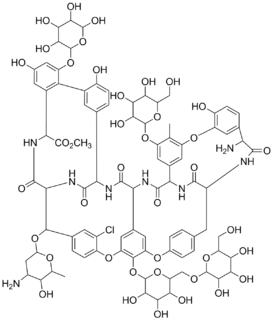
Daptomycin is a lipopeptide antibiotic used in the treatment of systemic and life-threatening infections caused by Gram-positive organisms. It is a naturally occurring compound found in the soil saprotroph Streptomyces roseosporus. Its distinct mechanism of action makes it useful in treating infections caused by multiple drug-resistant bacteria. It is marketed in the United States under the trade name Cubicin by Cubist Pharmaceuticals.

Surfactin is a very powerful surfactant commonly used as an antibiotic. It is a bacterial cyclic lipopeptide, largely prominent for its exceptional surfactant power. Its amphiphilic properties help this substance to survive in both hydrophilic and hydrophobic environments. It is an antibiotic produced by the Gram-positive endospore-forming bacteria Bacillus subtilis. In the course of various studies of its properties, surfactin was found to exhibit effective characteristics like antibacterial, antiviral, antifungal, anti-mycoplasma and hemolytic activities.
In enzymology, an aculeacin-A deacylase is an enzyme that catalyzes the chemical reaction that cleaves the amide bond in aculeacin A and related neutral lipopeptide antibiotics, releasing the long-chain fatty acid side chain.
A lipopeptide is a molecule consisting of a lipid connected to a peptide. Bacteria express these molecules. They are able to self-assemble into different structures. Certain lipopeptides are used as antibiotics. Other lipopeptides are toll-like receptor agonists. Lipoproteins are self-assembling molecules that are able to form structures. Certain lipopeptides can have strong antifungal and hemolytic activities. It has been demonstrated that their activity is generally linked to interactions with the plasma membrane, and sterol components of the plasma membrane could play a major role in this interaction. It is a general trend that adding a lipid group of a certain length to a lipopeptide will increase its bactericidal activity. Lipopeptides with a higher amount of carbon atoms, for example 14 or 16, in its lipid tail will typically have antibacterial activity as well as anti-fugal activity.

Echinocandin B, a lipopeptide, is a naturally occurring cyclic hexapeptide with a linoleoyl side chain. It belongs to a class of antifungal agents called echinocandins, which inhibits the synthesis of glucan, a major component of the fungal cell wall, via noncompetitive inhibition of a crucial enzyme, β-(1→3)-D-glucan synthase. Echinocandin B is a fermentation product of Aspergillus nidulans and the closely related species, A. rugulosus; discovered in 1974 in A. nidulans var. echinulatus strain A 32204 in Germany, it was the first of the echinocandin class of antifungals.

Ramoplanin (INN) is a glycolipodepsipeptide antibiotic drug derived from strain ATCC 33076 of Actinoplanes.

Bactoprenol is a lipid first identified in certain species of lactobacili. It is a hydrophobic alcohol that plays a key role in the growth of cell walls (peptidoglycan) in Gram-positive bacteria.

Valienamine is a C-7 aminocyclitol found as a substructure of pseudooligosaccharides such as the antidiabetic drug acarbose and the antibiotic validamycin. It can be found in Actinoplanes species.

Cubist Pharmaceuticals was an American biopharmaceutical company with activities spanning from research and development to commercialization of pharmaceutical products. Its main products target pathogens like MRSA.
Actinoplanes is a genus in the family Micromonosporaceae. They have aerial mycelia and spherical, motile spores. Actinoplanes species produce the pharmaceutically important compounds valienamine, teicoplanin, and ramoplanin.

Actinoplanes italicus is distinguished by the cherry-red color of its vegetative mycelium, and by the production of soluble pigments. It is also known to produce sporangia when cultured on starch or skim milk agar. Very few strains have been found and cultured, thus A. italicus is relatively uncharacterized.

Actaplanin is a complex of broad-spectrum antibiotics made by Actinoplanes bacteria. Research carried out by a group in Eli Lilly and Co. in 1984 identified several actaplanins using high-performance liquid chromatography. Actaplanins A, B1, B2, B3, C1 and G were shown to be composed of the same peptide core, an amino sugar, and varying amounts of glucose, mannose, and rhamnose.

Gardimycin is a peptide lantibiotic made by Actinoplanes brasiliensis.
Actinoplanes friuliensis is a species of bacteria that produces lipopeptide antibiotics with peptidoglycan synthesis-inhibiting activity, called friulimicins.

Paenibacterin is a mixture of antimicrobial lipopeptides isolated from Paenibacillus thiaminolyticus. It contains three isomeric compounds which differ by the fatty acid side chain.

Mycosubtilin is a natural lipopeptide with antifungal and hemolytic activities and isolated from Bacillus species. It belongs to the iturin lipopeptide family.
Actinoplanes xinjiangensis is a Gram-positive and antibiotic-resistant bacterium from the genus of Actinoplanes which has been isolated from the Xinjiang Uyghur Autonomous Region in China.
Actinoplanes bogorensis is a bacterium from the genus of Actinoplanes which has been isolated from isolated from leaf litter from Indonesia.
Actinoplanes nipponensis is a Gram-positive and antibiotic-producing bacterium from the genus of Actinoplanes which has been isolated from soil from Japan.

The arylomycins are a class of antibiotics initially isolated from a soil sample obtained in Cape Coast, Ghana. In this initial isolation, two families of closely related arylomycins, A and B, were identified. The family of glycosylated arylomycin C lipopeptides were subsequently isolated from a Streptomyces culture in a screen for inhibitors of bacterial signal peptidase. The initially isolated arylomycins have a limited spectrum of activity against Gram-positive bacteria, including Staphylococcus aureus and Streptococcus pneumoniae. The only activity against Gram-negative bacteria was seen in strains with a compromised outer membrane.












